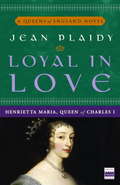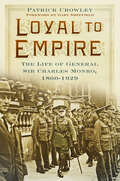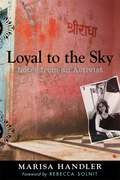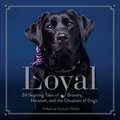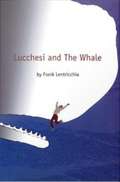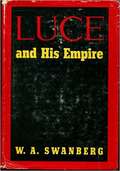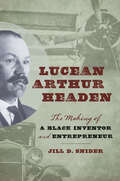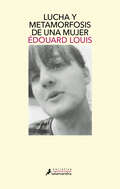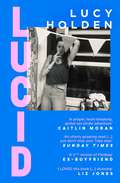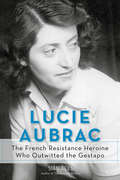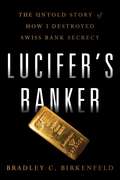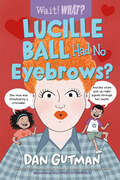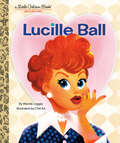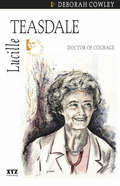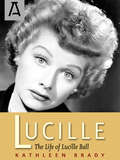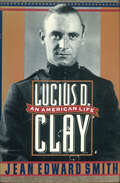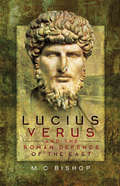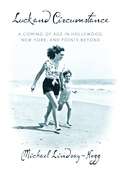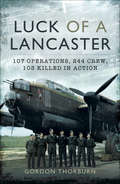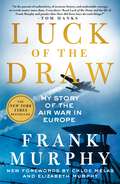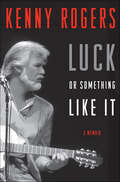- Table View
- List View
Loyal in Love: Henrietta Maria, Queen of Charles I (A Queens of England Novel #1)
by Jean PlaidyThe daughter of Henry IV of France, Princess Henrietta Maria, becomes a pawn in a political strategy to stabilize relations between two countries when her father marries her to Charles I of England. Sent abroad, she finds herself living in a Protestant country that views her own faith—Catholicism—with deep suspicion. Yet her new husband is a man of principle and integrity, and Henrietta and Charles fall deeply in love. Henrietta is passionate about her faith, however, and soon politically powerful people, namely Oliver Cromwell and his Puritans, turn her loyalty to her religion into a focal point for civil war. As the royal couple watch the fall of Thomas Wentworth, first Earl of Strafford, the rise of Puritanism, and Englishmen fight Englishmen, they are undeterred in their dedication to each other and in their belief in the divine rights of king and queen—even as spies lurk in their very own household. Loyal in Loveoffers an inside look at an unforgettable time in England’s history and at the life of a queen whose story of devotion and bravery has gone untold for too long. From the Trade Paperback edition.
Loyal to Empire: The Life of General Sir Charles Monro, 1860-1929
by Gary Sheffield Patrick CrowleyWinston Churchill did not describe General Sir Charles Monro in the most glowing terms. Referring to Monro’s brave decision to recommend a withdrawal from the Gallipoli disaster, Churchill said: ‘He came, he saw, he capitulated.’ Monro was one of a handful of senior officers selected to command a division with the British Expeditionary Force in 1914 and also led a corps on the Western Front as the war progressed. After Gallipoli he was instrumental in supporting the war effort from India as commander-in-chief and was directly involved in the aftermath of the Amritsar massacre by Brigadier General Dyer. His earlier life included distinguished service on the North West Frontier and in South Africa, and he was responsible for dramatically improving tactics within the army. Loyal to Empire brings to life the interesting character of General Monro, perhaps the least well known of all the British First World War commanders, and reassesses the legacy of his important military contributions.
Loyal to the Sky: Notes from an Activist
by Marisa HandlerCombining captivating personal memoir and astute political reportage, Marisa Handler offers a fascinating inside look at the burgeoning global justice movement through her own compelling coming-of-age story. Born in apartheid South Africa, Handler emigrated to Southern California at the age of twelve. Her gradual realization that injustice existed even in this more open, democratic society spurred a lifelong commitment to activism that would take her around the world and back again. Handler shares intimate details of her life as a global justice activist to offer a revealing perspective on what drives the movement. Tracing her own evolution as an activist, her story crisscrosses the globe, examining current sociopolitical issues from apartheid and racism to the Israeli-Palestinian conflict, corporate globalization, and the wars of the Bush administration. Along the way, Handler paints compelling portraits of the people she's encountered, shares gritty details of the sometimes-harrowing events that have changed and shaped her, and describes how she came to advocate a spiritually based, nonviolent activism as the best means for building the kind of world we wish to see.
Loyal: 38 Inspiring Tales of Bravery, Heroism, and the Devotion of Dogs
by Rebecca Ascher-WalshThis treasury features heartwarming photographs and touching stories of dedicated working dogs who have gone above and beyond the call of duty and proven themselves as true heroes.This special collection of dog stories and photographs features four-legged heroes who have worked side by side with soldiers, searched the wreckage of natural and man-made disasters, changed families' lives through emotional support, and administered aid around the world and at home in the United States. Heart-warming photographs and touching anecdotes bring to life thirty-eight caring canines who have served the people who mean the most to them, from a German Shepherd who leads a blind man on his marathon training mssion to a belly rub-loving Sheltie who supports at-risk youth in the classroom. For anyone who has experienced the extraordinary affection of a dog, Loyal is a lasting celebration of the joys of canine companionship.
Loyalties: A Son's Memoir
by Carl BernsteinThe events that shaped the author's childhood and led to the persecution of his parents during the McCarthy era.
Loyalty First: The Life and Times of Charles A. Willoughby, MacArthur's Chief Intelligence Officer
by David A. FoyFinalist, 2023 Army Historical Foundation Distinguished Writing Awards" ...provides critical texture to a historical figure often left pilloried without full context. The balanced treatment of a complex, flawed leader is valuable to understanding MacArthur’s command and an instructive lesson for today’s intelligence professionals and those who rely on intelligence to guide their decisions." — Aether: A Journal of Strategic Airpower & Spacepower Major General Charles A. Willoughby served as Douglas MacArthur's stalwart chief intelligence officer (G-2} for over a decade, throughout World War II and the Korean War. This first full biography examines Willoughby's shadowy origins in his native Germany, his curious arrival in the United States, and his military service in World War I, as well as his work during the interwar years as a junior diplomat, budding historian, and neophyte intelligence officer. His chance encounter with MacArthur in the mid-1930s would prove to be the genesis of a near-symbiotic relationship between the two, with significant consequences for both. Throughout his life, Willoughby identified with strong, authoritarian leaders, notably Franco, and—especially—MacArthur. The author also assesses Willoughby's performance as a professional intelligence officer both in World War II and Korea, where he is often vilified for his inaccurate assessments of enemy strength and most likely courses of action, as well as his sycophantic relationship with his commander. Willoughby is most often criticized for his failing to foresee the entry of Chinese forces into the Korean War and its impact upon the US Army and the prosecution of the war. Following MacArthur’s removal by President Truman in 1951, Willoughby retired and spent the rest of his days engaged in right-wing political activity and in staunchly defending his much-maligned boss. The legacy he left is one filled with lingering and important questions about loyalty to superiors, in civilian as well as military environments, how far that loyalty should extend, and walking the tightrope involved in telling truth to power.
Lucchesi and the Whale
by Frank LentricchiaLucchesi and The Whale is an unusual work of fiction by noted author and critic Frank Lentricchia. Its central character, Thomas Lucchesi Jr. , is a college professor in the American heartland whose obsessions and compulsions include traveling to visit friends in their last moments of life--because grief alone inspires him to write--and searching for secret meaning in Herman Melville's Moby-Dick. Himself a writer of "stories full of violence in a poetic style," Lucchesi tells his students that he teaches "only because [his] fiction is commercially untouchable" and to "never forget that. " Austerely isolated, anxiety-ridden, and relentlessly self-involved, Lucchesi nonetheless cannot completely squelch his eagerness for love. Having become "a mad Ahab of reading," who is driven to dissect the "artificial body of Melville's behemothian book" to grasp its truth, Lucchesi allows his thoughts to wander and loop from theory to dream to reality to questionable memory. But his black humor-tinged musings are often as profoundly moving as they are intellectual, such as the section in which he ponders the life and philosophy of Ludwig Wittgenstein in relation to the significance of a name--and then attempts to share these thoughts with a sexy, middle-aged flight attendant--or another in which he describes a chance meeting with a similarly-named mafia don. Despite apparent spiritual emptiness, Lucchesi in the end does find "a secret meaning" to Moby-Dick. And Lentricchia's creations--both Lucchesi and The Whale and its main character--reveal this meaning through a series of ingeniously self-reflective metaphors, in much the way that Melville himself did in and through Moby-Dick. Vivid, humorous, and of unparalleled originality, this new work from Frank Lentricchia will inspire and console all who love and ponder both great literature and those who would write it.
Luce and His Empire
by W. A. SwanbergHenry Luce started Time magazine in the 1940's and went on to create a media empire. He married Clare Booth Luce who became ambassador to Italy.<P><P> Pulitzer Prize Winner
Lucean Arthur Headen: The Making of a Black Inventor and Entrepreneur
by Jill D. SniderBorn in Carthage, North Carolina, Lucean Arthur Headen (1879–1957) grew up amid former slave artisans. Inspired by his grandfather, a wheelwright, and great-uncle, a toolmaker, he dreamed as a child of becoming an inventor. His ambitions suffered the menace of Jim Crow and the reality of a new inventive landscape in which investment was shifting from lone inventors to the new "industrial scientists." But determined and ambitious, Headen left the South, and after toiling for a decade as a Pullman porter, risked everything to pursue his dream. He eventually earned eleven patents, most for innovative engine designs and anti-icing methods for aircraft. An equally capable entrepreneur and sportsman, Headen learned to fly in 1911, manufactured his own "Pace Setter" and "Headen Special" cars in the early 1920s, and founded the first national black auto racing association in 1924, all establishing him as an important authority on transportation technologies among African Americans. Emigrating to England in 1931, Headen also proved a successful manufacturer, operating engineering firms in Surrey that distributed his motor and other products worldwide for twenty-five years.Though Headen left few personal records, Jill D. Snider recreates the life of this extraordinary man through historical detective work in newspapers, business and trade publications, genealogical databases, and scholarly works. Mapping the social networks his family built within the Presbyterian church and other organizations (networks on which Headen often relied), she also reveals the legacy of Carthage's, and the South's, black artisans. Their story shows us that, despite our worship of personal triumph, success is often a communal as well as an individual achievement.
Lucha y metamorfosis de una mujer
by Édouard LouisLa heroica transformación de una madre en un mundo dominado por los hombres. Édouard Louis se ha convertido en una de las plumas más temidas entre el poder establecido. Dotado de un estilo singular y una voz inconfundible, el nuevo enfant terrible de las letras galas ha transformado sus experiencias y sentimientos más íntimos en lacerantes historias de denuncia y catarsis, como su violación en vísperas de Navidades en Historia de la violencia o la tormentosa relación paternofilial en Quién mató a mi padre. En Lucha y metamorfosis de una mujer, Louis prosigue su ambicioso proyecto autobiográfico, que en esta ocasión focaliza en la figura de su madre, una mujer «apartada de todo, sojuzgada e incluso a veces humillada por la violencia masculina, que a los cuarenta y cinco años se rebeló, huyó y, poco a poco, construyó su libertad». La crítica ha dicho...«El escritor hace un retrato desu madre como una mujer destruida por la sociedad, la familia e incluso su hijo... antes de celebrar su reencuentro. Brillante.»Télérama «Dedicado a su madre, este libro parece en muchos sentidos el envés de Quién mató a mi padre. Y la dimensión teatral del texto hace que el orgullo de ser hijo de esta mujer sea sensible y conmovedor.»Le Monde «Un libro sobre lo que el autor llama la arqueología de la destrucción de su madre. Un texto breve, a la vez que duro y profundamente conmovedor, que devuelve la dignidad a la madre.»La Presse «Desde Para acabar con Eddy Bellegueule, Édouard Louis ha demostrado y desmontado la violencia de la dominación. Después de Quién mató a mi padre, dedica Lucha y metamorfosis de una mujer a su madre. Una demostración implacable.»La Libre Belgique «Este pequeño libro trata de la reconstrucción. O de cómo una mujer sobrevivió a lo que debería haberla destrozado. [...] La metamorfosis de una madre y también la metamorfosis de un hijo.»Bibliobs «El viaje de una víctima de la violencia social y patriarcal hacia su emancipación. [...] Un fresco autobiográfico que dibuja un "mapa del mundo social".»LesInrocks
Lucharon por la justicia (¡Arriba la Lectura!, Level V #74)
by Jill McDougallNIMAC-sourced textbook. A lo largo de la historia, muchas personas han luchado por la justicia y la igualdad. Las seis personas que aparecen en este libro son ejemplos notables de lucha por lo que es justo. Gracias a su valor, liderazgo y sacrificio, mejoraron la vida de millones de personas. Hoy sus historias siguen inspirando a otros a luchar por un mundo más justo.
Luciana Aymar
by Luis CalvanoEl periodista especializado Luis Calvano recorre en Corazón de Leona lavida y los logros deportivos de Lucha Aymar. Flaca, alta, linda y talentosa: un combo irresistible. Son atributos de Luciana Aymar, la mejor jugadora de hockey sobre césped de todos los tiempos según el consenso #insólitamente unánime# del ambiente del deporte. Y según las estadísticas. En 2009, la rosarina fue votada por sexta vez en su carrera como top player del año; ningún otro jugador, hombre o mujer, había sido premiado más de tres veces. Un recorrido por sus primeros clubes, la selección, el nacimiento mítico de Las Leonas en Sydney, el Mundial, las medallas. Pero también está la otra cara de la campeona: la infancia en Fisherton, sus viajes por el mundo, las villas olímpicas por dentro, sus amores, el acercamiento gradual a los mundos de la moda y de la televisión. "Lucha transmite felicidad, amor, pasión y humildad: eso es lo que debe mantener. Porque el esfuerzo más grande en su vida fue lograr trascender a la mejor jugadora del mundo y convertirse en un ejemplo." Cachito Vigil "Nunca imaginé que iba a tener la oportunidad de expresar mis vivencias y dejarlas plasmadas para siempre en un libro. Hoy me encuentro ante esa chance de contar las alegrías y las tristezas, las ganas que tengo de disfrutar la vida aunque haya momentos desagradables. ¿Y qué? En definitiva, esos momentos son los que nos dan la certeza de que estamos vivos." Luciana Aymar
Lucid: A memoir of an extreme decade in an extreme generation
by Lucy Holden'In Bath I lay in a field with headphones on, drunk, and staring at an empty blue sky that reflected nothing of the chaos in the world. Below the fields flashed the seaweed-green of a London train and I imagined my former life at the end of it but felt more like it had been tied to the tracks and careered over at 100 mph.' After a wild decade of hedonistic city life that veered violently into trauma, Lucy Holden was thrown back down the ladder to her parents&’ house in a pandemic which paused the parties and forced her to ask herself how she&’d become who she&’d become? Grown-up, broken-down, completely lost, then locked-in – Lucy realises she can&’t make it up as she goes along forever and instead has to confront the darkness she&’s been running from her entire adult life. In this raw, hilarious and often emotional memoir about a young woman asking herself how long she has until her act cracks completely, the mental health of a fast-paced world that never sits still is called into question. With charm and wit, Lucid addresses what it means to be young in today&’s society – and where we can go from here.
Lucie Aubrac: The French Resistance Heroine Who Outwitted the Gestapo
by Siân ReesBrilliant, intensely political, and inseparable for nearly 70 years, Lucie Aubrac and her husband, Raymond, are legendary figures of the French Resistance. Founding leaders of Libération-Sud, one of the most important resistance movements in France, they ran the underground newspaper Libération and served as couriers, arms carriers, and saboteurs. In 1943, when the Gestapo imprisoned Raymond, Lucie engineered a daring escape plan that brought her face to face with feared Gestapo chief Klaus Barbie. When Raymond was arrested again, Lucie mounted a second astonishing rescue, ambushing the prison van that was transporting him. For the post-war generation, the Aubracs were heroes. However, in 1983, Klaus Barbie made the bombshell claim that the Aubracs had become informers in 1943, betraying their comrades. Although later discredited, the allegations raised questions around the many embellishments and inconsistencies in the tales Lucie weaved around herself. Who was Lucie Aubrac? What did she really do in 1943? Siân Rees's penetrating account--the first English-language biography of this extraordinary woman--provides a long-needed corrective to Lucie Aubrac's own admittedly "impressionistic" memoir and a fascinating exploration of the intersection of history, legend, and mythologizing.
Lucifer's Banker: The Untold Story of How I Destroyed Swiss Bank Secrecy
by Bradley C. BirkenfeldA page-turning real-life thriller, Lucifer's Banker is a fascinating behind-the-scenes look at the secret Swiss high-net worth banking industry and a harrowing account of our government's justice system. Readers will follow Birkenfeld and share his outrage with the incompetence and possible corruption at the Department of Justice, and they will cheer him on as he "hammers" one of the most well-known and powerful banks in the world.
Lucille Ball Had No Eyebrows? (Wait! What? #0)
by Dan GutmanFrom the best-selling author of My Weird School: a new entry in the cheerful and engaging biography series centered on high-interest historic figures. Did you know that Lucille Ball could pick up radio signals through her teeth? Or that her career was almost destroyed because she was a registered Communist? Bet you didn’t know that, as a studio executive, she green-lit both Star Trek and Mission: Impossible! Siblings Paige and Turner have collected some of the most unusual and surprising facts about the beloved actress, from her impoverished childhood and her first forays into the film industry to her marriage with Desi Arnaz and her rise to become both the most prominent actress in television and one of its most successful executives. Narrated by the two spirited siblings and animated by Allison Steinfeld’s upbeat illustrations, Wait! What? Lucille Ball Had No Eyebrows? is an authoritative, accessible, and one-of-a-kind biography infused with Dan Gutman’s signature zany sense of humor.
Lucille Ball: A Little Golden Book Biography (Little Golden Book)
by Wendy LoggiaHelp your little one dream big with a Little Golden Book biography about Lucille Ball--and find out why everyone loves Lucy! It's the perfect introduction to nonfiction for preschoolers.This Little Golden Book about Lucille Ball--television star, comedian, producer, and the first woman to own a major studio--is a celebration of a true trailblazer! It's a great read-aloud for young children, as well as their parents and grandparents who grew up watching and loving I Love Lucy.Look for Little Golden Book biographies about these other inspiring people:Dwayne JohnsonQueen Elizabeth II Barack ObamaSonia Sotomayor Dr. FauciJoe BidenDolly PartonKamala HarrisMisty CopelandBetty WhiteFrida KahloRuth Bader GinsburgJackie RobinsonMartin Luther King Jr.
Lucille Teasdale
by Deborah CowleyCanadian surgeon Lucille Teasdale and her husband founded Lacor Hospital in northern Uganda in 1961. For 35 years the two doctors treated such contagious diseases as malaria, TB, and AIDS, and Teasdale performed thousands of operations under difficult conditions. They lived through civil war, hostage takings, and epidemics. Teasdale received the highest humanitarian awards from the U.N. for her lifes work in Africa.
Lucille: The Life of Lucille Ball
by Kathleen BradyEveryone loved Lucy, the scheming, madcap redhead who ruled television for more than twenty years. In life, however, Lucille Ball presented a far more complex and contradictory personality than was ever embodied by the television Lucy. In Lucille: The Life of Lucille Ball Kathleen Brady presents the actress as a fully rounded human being, often at odds with the image she presented as an entertainment icon. Brady has gone far beyond the typical celebrity biography to present a funny, unflinching and ultimately moving portrait of Lucille Ball as a performing artist, daughter, mother, friend, colleague, and television mogul. Many think they know the story of Lucille Ball's life, but Brady provides new details and a fresh perspective on this complex woman through a wealth of anecdotes and firsthand accounts. Lucille Ball is revealed not only as a television archetype and influential icon of postwar American culture, but as a driven yet fragile human being who spent her life struggling to create of life of normalcy, but ultimately failed--even as she succeeded in bringing laughter of millions of fans. In researching Lucille, Brady interviewed more than 150 people from her hometown to Hollywood. She spoke with her grade school classmates, and those like Katherine Hepburn and Ginger Rodgers who met her when she arrived in Hollywood in the 1930s. She gained insights from those who knew her before her fame and from those she loved throughout her life. Film, radio and television history come to life with the appearances on these pages of such greats as The Marx Brothers, Buster Keaton, Louis B. Mayer, and of course Desi Arnaz, who march and pratfall through the pages of this outstanding biography.
Lucius D. Clay: An American Life
by Jean Edward SmithSoldier, statesman, logistical genius: Lucius D. Clay was one of that generation of giants who dedicated their lives to the service of this country, acting with ironclad integrity and selflessness to win a global war and secure a lasting peace. A member of the Army's elite Corps of Engineers, he was tapped by FDR in 1940 to head up a crash program of airport construction and then, in 1942, Roosevelt named him to run wartime military procurement. For three years, Clay oversaw the requirements of an eight-million-man army, setting priorities, negotiating contracts, monitoring production schedules and R&D, coordinating military Lend-Lease, disposing of surplus property-all without a breath of scandal. It was an unprecedented job performed to Clay's rigorous high standards. As Eliot Janeway wrote: "No appointment was more strategic or more fortunate."If, as head of military procurement, Clay was in effect the nation's economic czar, his job as Military Governor of a devastated Germany was, as John J. McCloy has phrased it, "the nearest thing to a Roman proconsulship the modern world afforded." In 1945, Germany was in ruins, its political and legal structures a shambles, its leadership suspect. Clay had to deal with everything from de-Nazification to quarrelsome allies, from feeding a starving people to processing vast numbers of homeless and displaced. Above all, he had to convince a doubting American public and a hostile State Department that German recovery was essential to the stability of Europe. In doing so, he was to clash repeatedly with Marshall, Kennan, Bohlen, and Dulles not only on how to treat the Germans but also on how to deal with the Russians. In 1949, Clay stepped down as Military Governor of Germany and Commander of U.S. Forces in Europe. He left behind a country well on the way to full recovery. And if Germany is today both a bulwark of stability and an economic and political success story, much of the credit is due to Clay and his driving vision.Lucius Clay went on to play key roles in business and politics, advising and working with presidents of both parties and putting his enormous organizing skills and reputation to good use on behalf of his country, whether he was helping run Eisenhower's 1952 campaign, heading up the federal highway program, raising the ransom money for the Bay of Pigs prisoners, or boosting morale in Berlin in the face of the Wall. The Berliners in turn never forgot their debt to Clay. At the foot of his West Point grave, they placed a simple stone tablet: Wir Danken Dem Bewahrer Unserer Freiheit- We Thank the Defender of Our Freedom.
Lucius Verus and the Roman Defence of the East
by M.C. Bishop&“The first biography of Marcus Aurelius&’ adopted brother and co-emperor . . . a valuable read for anyone with an interest in Roman history.&”—The NYMAS Review Lucius Verus is one of the least regarded Roman emperors, despite the fact that he was co-ruler with his adoptive brother Marcus Aurelius for nine years until his untimely death. The later sources were strangely hostile to him and modern writers tend to dismiss him, but contemporary writings shine a more favorable light on his accomplishments. His handling of military affairs, particularly the conflict with Parthia after their invasions of Armenia and Syria, deserves a new consideration in the light of a careful reassessment of all the available source material. This volume looks at the upbringing of the boy who lost two fathers, acquired a brother, had his name changed twice, became a general overnight, and commanded the army that defeated one of Rome&’s greatest foes in the 2nd century AD. His rise to power is placed in the context of Rome&’s campaigns in the East and the part played by all—from the ordinary soldiers up to the aristocracy who commanded them—in making Lucius Verus&’s Parthian Wars a success. &“Bishop&’s background is in Roman military archaeology, and where the details of Roman warfare are concerned, he knows his subject matter backwards and forwards . . . For those who wish to understand how the Roman commanders fighting under Verus achieved success in the East, Bishop&’s book can be heartily recommended.&”—Bryn Mawr Classical Review
Luck and Circumstance: A Coming of Age in Hollywood, New York, and Points Beyond
by Michael Lindsay-HoggFrom acclaimed director Michael Lindsay-Hogg (The Normal Heart, The Beatles' Let It Be, Brideshead Revisited, The Rolling Stones Rock and Roll Circus, etc.), son of glamorous Warner's movie star Geraldine Fitzgerald: a magical dreamscape memoir of his boyhood, coming-of-age, and making his way in the worlds of theater, film, and television. Lindsay-Hogg's father, an English baronet from a family whose money came from the China trade, lived in Ireland and was rarely seen by his son. The author's stepfather was the scion of the Isidor Straus fortune, co-owner of R. H. Macy's; Straus went down with the Titanic, and the author's stepfather was, alas, fortune-less. The author's mother, Geraldine Fitzgerald, the redheaded Irish seductress who won instant acclaim as Bette Davis's best friend in Dark Victory and in William Wyler's Wuthering Heights, spent time with Hollywood's elite--Laurence Olivier, Charles Chaplin, and Orson Welles, with whom she worked in New York at the Mercury Theater and in other productions. Lindsay-Hogg writes of how he wented his way into this exotic, mysterious, and seductive world, encountering as a small boy the likes of Marion Davies and William Randolph Hearst, playing hide-and-seek with Olivia de Havilland, serving drinks to Humphrey Bogart, discussing life with Henry Miller. At the book's center, an offhand comment made to Lindsay-Hogg by his mother, when he was sixteen, about talk circulating (false, she claimed) that she had had a romantic relationship with Orson Welles (Fitzgerald and Welles had lived together at his home in Beverly Hills) and that Welles, rumor had it, was Michael's father ("It's not true," she said. "You know how people put two and two together and get three . . ."). That was the end of the conversation. ("It's time for bed . . . You have school in the morning . . ." she said.) For Lindsay-Hogg, it opened up a whole new realm of his life. He was forever changed by the knowing--of not knowing. Interwoven throughout his narrative is the element of questioning who his father was. Was he the patron saint of American pictures, the legendary genius of the twentieth century, Orson Welles, a consistently inconsistent person in Michael's life . . . or was he the man who considered himself Michael's real father? What did his "father" know? What did Welles know? And what did his mother know to be true (she had brought the author up to believe that she always told the truth)? And when would she tell her son what the truth was . . . As Lindsay-Hogg struggled to make sense of it all, questions of missed chances, conversations never had, questions of what is withheld and what is true took root, dogging him, shaping his life . . . questions still, that haunt and inform this moving, deft, and illuminating memoir.From the Hardcover edition.
Luck of a Lancaster: 107 Operations, 244 Crew, 103 Killed in Action
by Gordon ThorburnNo 9 Squadron of Bomber Command converted from the Wellington to the Lancaster in August 1942. W4964 was the seventieth Lanc to arrive on squadron, in mid April 1943. She flew her first op on the 20th, by which time No 9 had lost forty-one of their Lancs to enemy action and another five had been transferred to other squadrons and lost by them. No 9 would soon lose a further thirteen of the seventy. All of the remaining eleven would be damaged, repaired, transferred to other squadrons or training units, and lost to enemy action or crashes except for three which, in some kind of retirement, would last long enough to be scrapped after the war.Only one of the seventy achieved a century of ops or anything like it: W4964 WS-J.Across all squadrons and all the war, the average life of a Lancaster was 22.75 sorties, but rather less for the front-line squadrons going to Germany three and four times a week in 1943 and '44, which was when W4964 was flying her 107 sorties, all with No 9 Squadron and all from RAF Bardney. The first was Stettin (Szczecin in modern Poland), and thereafter she went wherever 9 Squadron went, to Berlin, the Ruhr, and most of the big ops of the time such as Peenemnde and Hamburg. She was given a special character as J-Johnny Walker, still going strong and on September 15 1944, skippered by Flight Lieutenant James Douglas Melrose, her Tallboy special bomb was the only one to hit the battleship Tirpitz.During her career, well over two hundred airmen flew in J. None were killed while doing so, but ninety-six of them died in other aircraft. This is their story, and the story of one lucky Lancaster.
Luck of the Draw: My Story of the Air War in Europe
by Frank MurphyThe epic true story of an American hero who flew during WWII, soon to be featured in the upcoming Steven Spielberg and Tom Hanks TV Series, Masters of the Air. <p><p>Beginning on August 17, 1942, American heavy bomber crews of the Eighth Air Force took off for combat in the hostile skies over occupied Europe. The final price was staggering. 4,300 B-17s and B-24s failed to return; nearly 21,000 men were taken prisoner or interned in a neutral country, and a further 17,650 made the ultimate sacrifice. Luck of the Draw is more than a war story. It’s the incredible, inspiring story of Frank Murphy, one of the few survivors from the 100th Bombardment Group, who cheated death for months in a German POW camp after being shot out of his B-17 Flying Fortress. <p><p>Now with a new foreword written by his granddaughter Chloe Melas, of CNN, and daughter Elizabeth Murphy. <p> <b>New York Times Bestseller</b>
Luck or Something Like It: A Memoir
by Kenny RogersA living legend of Country Music and a worldwide music icon, superstar Kenny Rogers has enjoyed a fascinating five decades in show business, and he tells the full story of his remarkable life and career in Luck or Something Like It. From his days with hit group The First Edition to his sterling solo work, the artist who "knows when to hold 'em and knows when to fold 'em" knows how to tell a captivating life story as well–bringing a golden era of Country Music to life as he recounts his remarkable rise to the top of the charts. An honest, moving, eye-opening view of a musician's life on the road, Luck or Something Like It is the definitive music memoir–a backstage pass to fifty years of performing and recording presented by the one and only Kenny Rogers, one of the bestselling artists ever.
